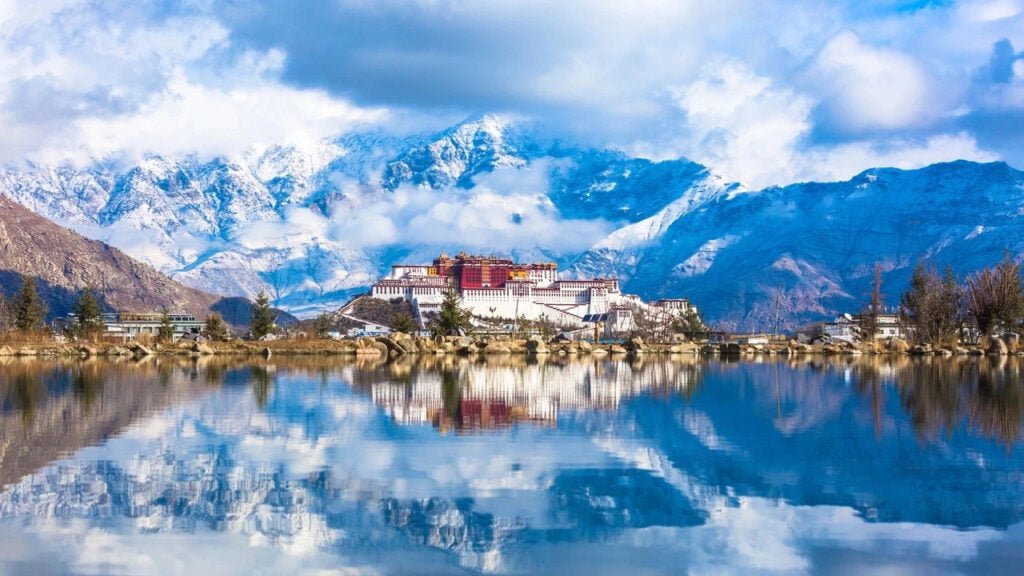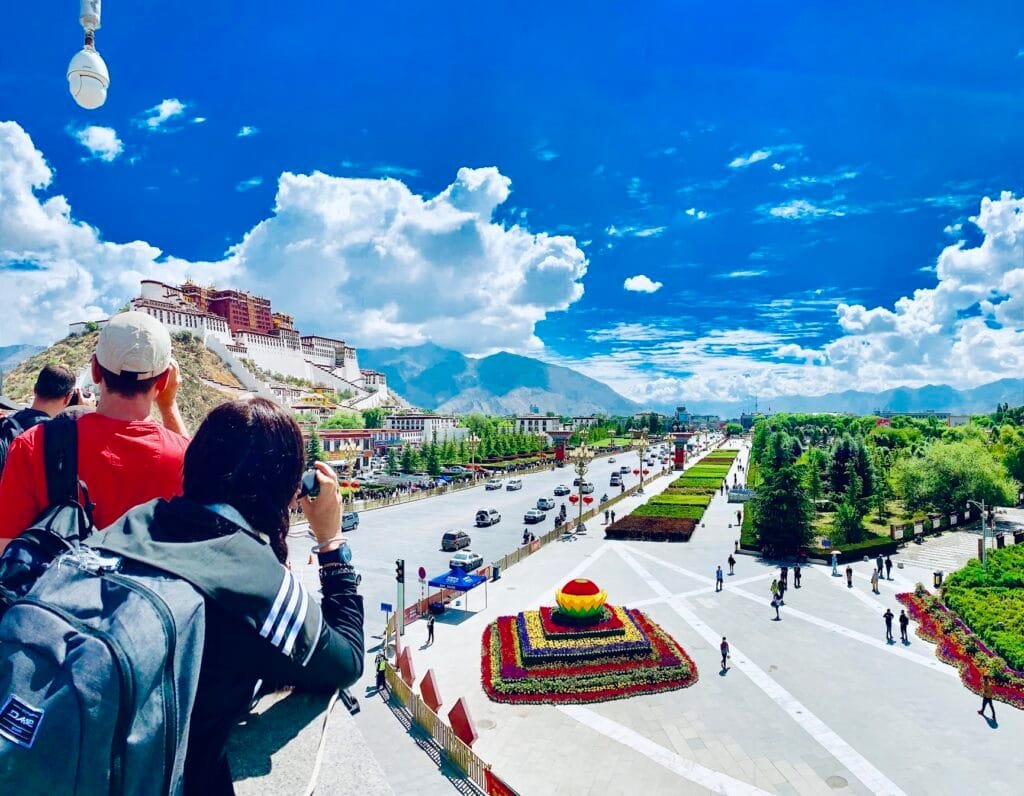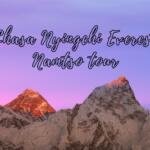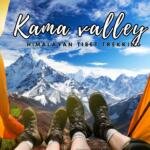Tibet cradled within the majestic Himalayas, is a realm of unparalleled natural beauty and rich cultural heritage. Its mystical landscapes and profound spiritual aura captivate the hearts of travellers. Among its jewels are Lhasa, Gyangste, and Shigatse – each a beacon for adventurers and spiritual seekers.
Lhasa, the heart of Tibet, harmoniously blends ancient traditions with modern vibrancy. Its streets, a tapestry of historic monasteries and palaces, weave through bustling markets and contemporary structures. Dominating the cityscape is the Potala Palace, perched majestically on a hill, its halls a treasure trove of murals and statues echoing the ancient Tibetan era.
Shigatse, Tibet’s second-largest city, is a haven for nature enthusiasts. The grandeur of the Tashilhunpo Monastery, with its golden-roofed buildings and sacred temples, stands as its crown jewel and the residence of the Panchen Lama. Exploring these cities offers a journey through centuries of spiritual and cultural evolution, unveiling the soul of Tibet.
Lost Cities Uncovered: Rediscovering Tibet Civilization’s Forgotten Gems –
Step into History’s Footprints of Lhasa and Shigatse
Welcome to Lhasa: Day 1 – Arrival and Acclimatization
Welcome to the enchanting city of Lhasa! Upon your arrival at Lhasa Airport, our hospitable team will greet you, offering a warm introduction to the plateau’s charm. The first day in Tibet is crucial for acclimatization, so we’ve arranged a comfortable transfer to your hotel where you can relax and adjust to the high altitude.
Lhasa, revered as the “Holy Land” by Tibetans, is a haven for travellers seeking a blend of sacredness and beauty. With the Qinghai-Tibet Railway, reaching this magical city has become easier. Yet, the true spirit of Lhasa extends beyond its vibrant streets, inviting you to explore its mystical allure.
Travel Tips:
Airport Shuttle: Our local professionals ensure seamless airport transfers. Please keep your mobile phone accessible for communication. Tour guides are mandatory for foreign and Taiwanese tourists for station pick-up, while Chinese nationals will be met directly by the guide.
Altitude Sickness Precautions:
- Refrain from strenuous activities on your first day.
- Avoid bathing and alcohol consumption.
- Stay hydrated, eat fruits in moderation, and ensure ample rest.
- Consider bringing altitude sickness remedies like American ginseng lozenges or Rhodiola rosea.
Lhasa City Tour: Day 2 – Potala Palace and Tibetan Cultural Experience


Potala Palace Tour: A Dive into Ancient Tibetan History
- Historical Significance: Embark on a one-hour exploration of the breathtaking Potala Palace, built by the legendary Songtsan Gampo. This architectural marvel is a testament to ancient Tibetan history, encompassing Buddhist halls, pagodas, living quarters, and corridors.
- Atmospheric Journey: As you wander through the palace, experience the ethereal ambience created by dim lights, low-hanging curtains, and the scent of butter lamps. It’s a journey back in time, surrounded by scriptures, Buddha statues, murals, and age-old legends.
Booking Guidelines for Potala Palace Tickets:
- Reservation Requirements: Tickets to Potala Palace need to be reserved under your real name with valid identification (ID card, household registration, or passport).
- Booking Limitation: After booking, you can’t reserve another ticket within 7 days. Ensure to bring the original ID used for booking. Refunds are not available for name or identification mismatches.
- Visit Times: The management office assigns visit times randomly, and specific visit times cannot be requested. The itinerary sequence might differ from the plan.
- Peak Season Arrangements: During busy seasons, the travel agency may adjust plans to ensure a seamless visit, which could include split groups, staggered visit times, and different guides.
Tibetan Cultural Immersion Experience:
- Crafting Tibetan Incense: Participate in making traditional Tibetan incense at the Tibetan Culture Experience Center, offering a hands-on understanding of this age-old craft.
- Personalized Tibetan Calligraphy: Learn to write your name in Tibetan and have it engraved for a unique souvenir.
- Memorable Takeaways: These handmade incense and personalized texts are the perfect souvenirs to remember your cultural journey.
Embark on this enriching journey through Lhasa’s Potala Palace and immerse yourself in Tibetan culture for a truly unforgettable experience.
Scenic Drive from Lhasa to Shigatse via Yamdrok Lake – Day 3
Embark on a picturesque journey from Lhasa to Shigatse, traversing the breathtaking landscapes of Tibet. This 380km drive, taking approximately 7 hours, offers an immersive experience into the heart of Tibetan natural beauty.
En Route: Yarlung Zangbo River Valley
- Begin your day by departing from Lhasa and travelling through the expansive Yarlung Zangbo River valley. This journey allows you to witness the stunning vistas of the river and get a glimpse of the local Tibetan way of life.
Yamdrok Yongcuo (Yamdrok Lake) Visit
- Yamdrok Yongcuo, one of the three largest sacred lakes in Tibet, is renowned for its stunning beauty. Surrounded by snow-capped mountains, its waters display a mesmerizing spectrum of colours from deep blue to vibrant turquoise. As per Tibetan Buddhist beliefs, the lake is the lifeline of Tibet. Enjoy photo stops around the lake to capture its enchanting beauty from various perspectives.
Karola Glacier Exploration
- As you proceed, encounter the magnificent Karola Glacier, situated at the crossroads of the Lhasa-Shigatse and Lhasa-Nyingchi highways. Surrounded by towering mountains, this glacier is a sight to behold. Pause here to appreciate this natural marvel and take memorable photographs.
Arrival in Shigatse
- Conclude your day in Shigatse, Tibet’s second-largest city, a hub of rich cultural heritage. Home to the historic Tashilhunpo Monastery, which you’ll visit tomorrow, Shigatse offers an evening of exploration and relaxation.
Travel Tips for Shigatse:
Continue to acclimate to the high altitude. Drink plenty of water and rest when needed. Try Tibetan dishes at local restaurants. Ask your guide for the best dining spots in Shigatse. Feel free to stroll through the city, but remember to return to your hotel in time for a restful night. Prepare for a day filled with stunning natural landscapes and enriching cultural experiences as you journey from Lhasa to Shigatse, immersing yourself in the heart of Tibet.
Day 4: Shigatse Exploration – Tashilhunpo Monastery and Local Market
Embrace the vibrant spirit of Shigatse, visiting the iconic Tashilhunpo Monastery and experiencing the local market’s charm.
Tashilhunpo Monastery Discovery:
- Spiritual Landmark: Dive into the heart of Tibetan Buddhism with a visit to Tashilhunpo Monastery, the revered seat of the Panchen Lama. This monastery is not just a religious site but a testament to Tibetan architecture and history.
- Architectural Marvel: Tour the monastery’s halls, courtyards, and chapels, admiring the intricate design and cultural significance.
- Maitreya Buddha Statue: Behold the world’s largest gilded Maitreya Buddha statue, a symbol of peace and hope.
- Monastic Life Insights: Gain a deeper understanding of Tibetan Buddhism and the daily life of monks within these sacred walls.
Return Journey to Lhasa:
- Scenic Drive: As you head back to Lhasa, enjoy the beautiful landscapes of the Tibetan plateau. Feel free to request photo stops to capture the journey’s scenic beauty.
- Cultural Insights: Utilize this time to discuss Tibetan culture and history with your guide, enriching your understanding of the region.
Arrival in Lhasa:
- Hotel Drop-off: Arrive back in Lhasa by late afternoon or early evening. Relax and rejuvenate at your hotel after the day’s adventures.
- Culinary Options: For your final night in Tibet, dine at your hotel or explore Lhasa’s local cuisine. Your guide can recommend restaurants to suit your taste.
Day 4 in Shigatse is a blend of spiritual enlightenment and cultural immersion, offering a glimpse into the heart of Tibetan Buddhism and the local way of life.
Departure from Lhasa – Day 5
Your memorable journey through Tibet comes to an end today. After breakfast, you’ll check out of your hotel in Lhasa and proceed to Lhasa Gonggar Airport for your departure flight. Your guide and driver will accompany you to the airport and assist with any necessary procedures.
Travel Tips for Departure:
- Ensure you have all your belongings packed and ready before checking out of the hotel.
- Double-check your flight details, including the departure time and terminal.
- Arrive at Lhasa Gonggar Airport well in advance of your flight to allow time for security checks and other formalities.
- Have a safe and pleasant journey home, and cherish the memories of your incredible adventure in Tibet.
Please note that this itinerary provides a general outline of a Tibet tour, and actual schedules and activities may vary depending on factors such as weather conditions, road conditions, local events, and the availability of specific sites. Your local guide will provide you with the most up-to-date information and ensure your trip runs smoothly.








